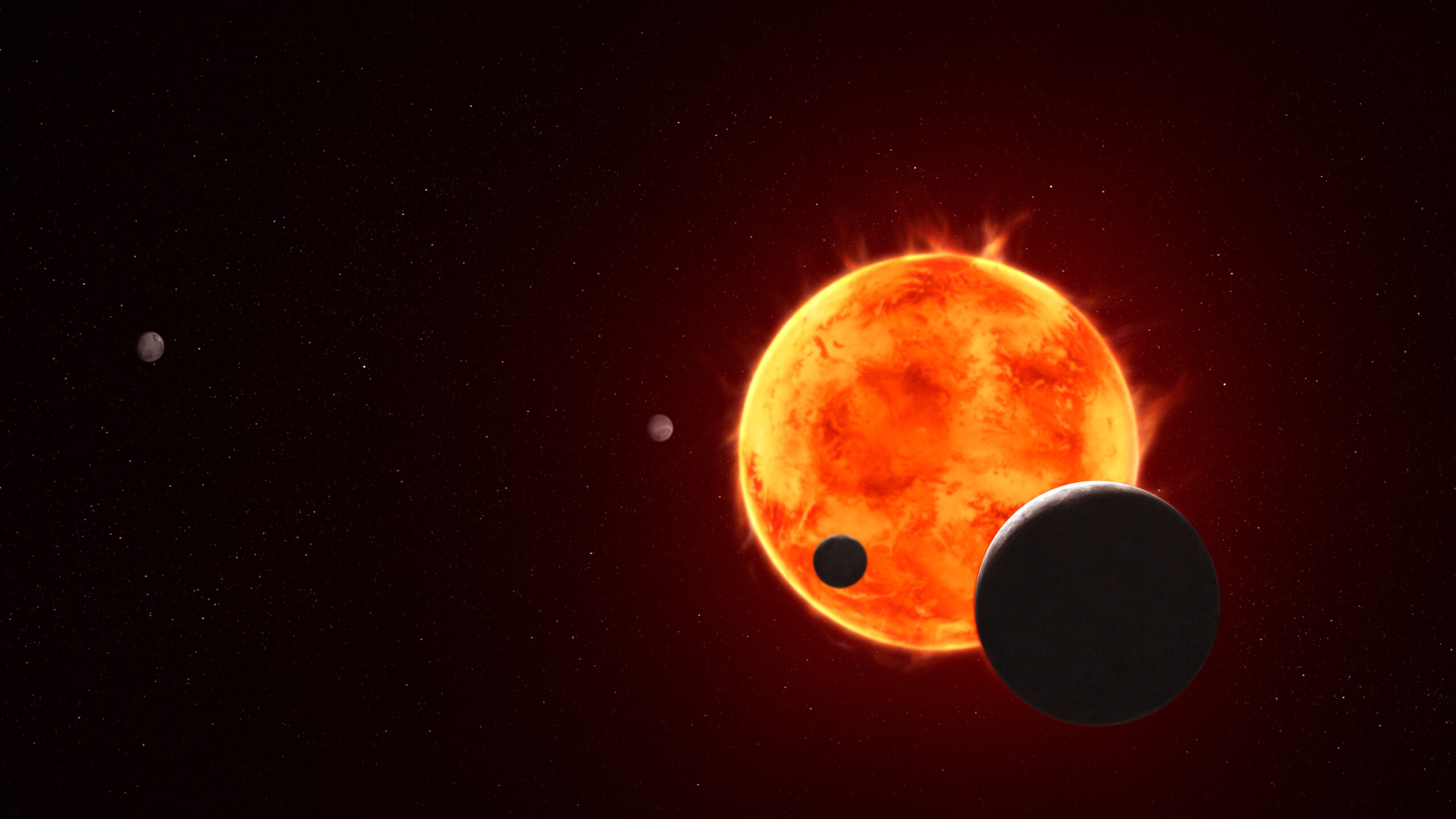Now Reading: Potentially habitable planet TRAPPIST-1e displays tentative evidence for an atmosphere
-
01
Potentially habitable planet TRAPPIST-1e displays tentative evidence for an atmosphere
Potentially habitable planet TRAPPIST-1e displays tentative evidence for an atmosphere


Astronomers have seen tentative evidence for an atmosphere on TRAPPIST-1e, an Earth-sized rocky planet 40 light years away.
The planet is the fourth of seven orbiting the ultracool red dwarf star TRAPPIST-1, and lies within the star’s habitable zone where liquid water could exist if an atmosphere is present.
Using the James Webb Space Telescope’s Near-Infrared Spectrograph instrument, the team observed TRAPPIST-1e as it passed in front of its parent star four times between mid- to late- 2023. If TRAPPIST-1e has an atmosphere, the gases would absorb certain wavelengths of the star’s infrared light. This would show up on a graph as deviations from a flat line.
“The bumps and wiggles appear to be in the right place,” says Ryan MacDonald, Lecturer in Extrasolar Planets at the University of St Andrews, Lecturer in Extrasolar Planets at the University of St Andrews, who contributed to the analysis of the observations.
Yet while the signs are good, the team are not yet claiming a definitive detection.
“We’re at a very early stage. We have two models for the planet. The atmosphere model is an excellent fit to what we see, but our errors are large enough that we can’t rule out the null hypothesis,” MacDonald told Astronomy Now.
The null hypothesis is that the planet is simply a bare rock with no atmosphere at all. Such a barren disposition is certainly true for at least three of its sibling planets. Observations of TRAPPIST-1b, c and d all show the completely featureless spectrum characteristic of an atmosphere-less rocky planet, which is why these initial deviations for TRAPPIST-1e are so noteworthy.
Complicating the analysis of TRAPPIST-1e, is the magnetic activity of its host star. This causes starspots, the equivalent of sunspots on our own star, which can mimic or obscure the atmospheric signals the team are searching for.
The researchers spent more than a year disentangling these stellar artefacts from the data before they could even start looking for an atmospheric signal. And so, with four observations under their belt, they felt confident enough to give an update but not to claim a detection. They are now in the process of gathering 15 additional observations of the planet transiting in front of its parent star to either confirm or deny the atmospheric signal.
“We are pushing JWST to its limits,” says MacDonald.
Even if an atmosphere is not present on this world, MacDonald says that the observation will still be telling us something profound about planetary habitability. It will be telling us that rocky planets find it hard to hold on to atmospheres close to red dwarf stars.
If the atmosphere is confirmed, however, then it gets really exciting. In order to determine whether there is the possibility of liquid water on its surface, the team will have to use their readings to determine the chemical composition of TRAPPIST-1e’s atmosphere. In particular they will be looking for the abundance of naturally occurring greenhouse gases such as carbon dioxide and methane.
With these abundances in mind, they can calculate the surface temperature of the planet and see if it falls within 0-100°C. MacDonald hopes to have their next update on the search for TRAPPIST-1e’s atmosphere within 18 months.
The work is part of the JWST-TST DREAMS programme, led by Professor Nikole Lewis of Cornell University, and involves more than 30 scientists from the UK, USA, and India. These results are published in two papers in Astrophysical Journal Letters, an international team, including researchers from the University of St Andrews, report early results from the James Webb Space Telescope (JWST).
Further reading:
JWST-TST DREAMS: NIRSpec/PRISM Transmission Spectroscopy of the Habitable Zone Planet TRAPPIST-1e by Néstor Espinoza et al. in the Astrophysical Journal Letters, doi.org/10.3847/2041-8213/adf42e
Secondary Atmosphere Constraints for the Habitable Zone Planet TRAPPIST-1e by Ana Glidden et al. in the Astrophysical Journal Letters, doi.org/10.3847/2041-8213/adf62e
Stay Informed With the Latest & Most Important News
-
 012024 in Review: Highlights from NASA in Silicon Valley
012024 in Review: Highlights from NASA in Silicon Valley -
 02Panasonic Leica Summilux DG 15mm f/1.7 ASPH review
02Panasonic Leica Summilux DG 15mm f/1.7 ASPH review -
 03How New NASA, India Earth Satellite NISAR Will See Earth
03How New NASA, India Earth Satellite NISAR Will See Earth -
 04And Thus Begins A New Year For Life On Earth
04And Thus Begins A New Year For Life On Earth -
 05Astronomy Activation Ambassadors: A New Era
05Astronomy Activation Ambassadors: A New Era -
06SpaceX launch surge helps set new global launch record in 2024
-
 07Space Force plans new ‘Futures Command’ amid pressure to speed up modernization
07Space Force plans new ‘Futures Command’ amid pressure to speed up modernization


















